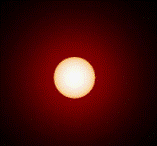Department of Physics and Astronomy: Publications and Other Research

Norman R. Simon Papers
Document Type
Article
Date of this Version
1989
Citation
Mon. Not. R. astr. Soc. (1989) 237,163-185.
Abstract
The Baade-Wesselink (BW) inversion technique is applied to three pulsators - the RRab stars SW Dra and X Ari, and the classical Cepheid, U Sgr. In this method, the observed light and colour curves are fitted with Fourier series and various surface brightness parameterizations are employed. We apply a number of tests and fail-safes to distinguish meaningful from fortuitous solutions. These tests evaluate the stability of the solution to both methodological changes, e.g. in the calculation mode or in the phase domain treated, and to changes in the treatment of the observations as expressed by the use of different Fourier fits. A surface brightness parameterization employing the V-K colour is found to be superior for RR Lyrae stars, but B-V is superior for classical Cepheids. We derive a consistent radius for SW Dra but are unable to do so for X Ari, probably due to gaps in the K magnitude data for the latter star. In the case of U Sgr, a radius is obtained but with unsatisfactory accuracy, again probably due to phase gaps in the photometry. The inversion technique is found to be highly sensitive to the observations and clearly selects the tightly defined Cousins photometry over the more loosely standardized Johnson photometry in the case of U Sgr. This argues for the physical reality of the parameterization employed. We compare our results with those of other authors and note some advantages of the BW inversion. Finally, we assert that, given highly accurate data and extensive coverage of the cycle (e.g. as in the SW Dra observations), the BW inversion technique can determine radii with methodological uncertainties (i.e. those connected with the details of how the method is applied and with observational errors) of only a few per cent.


Comments
Copyright 1989 Royal Astronomical Society.